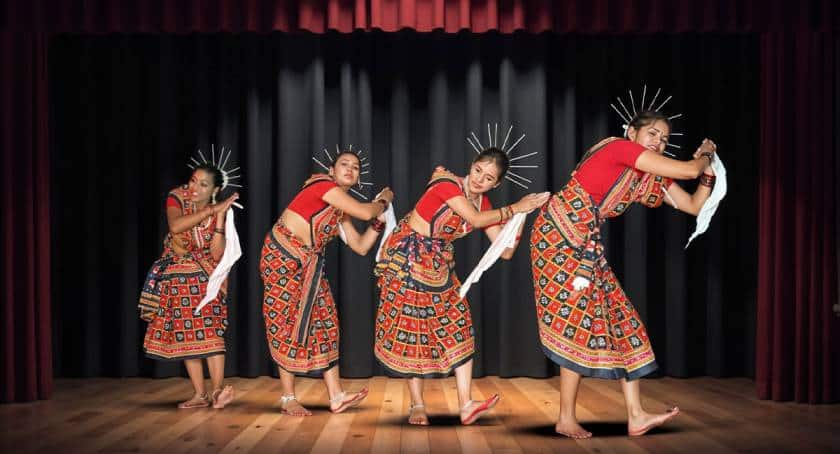Sambalpuri Traditional Dance
India, renowned for its diverse and vibrant cultural heritage, is home to numerous traditional dance forms that reflect its people’s rich traditions. Among these, the Sambalpuri Dance from Odisha holds a distinctive place. It is celebrated for its energetic moves, colorful attire, and deep cultural significance. This folk dance embodies the spirit of Western Odisha, bringing together history, traditions, and artistic expression. This blog examines the history, importance, styles, and current applicability of the Sambalpuri dance, emphasizing its influence on Indian traditional culture.
Origins and History of Sambalpuri Dance
Sambalpuri Dance originates from the western region of Odisha, particularly from Sambalpur, Bargarh, Balangir, and Sonepur. It is deeply rooted in the folk traditions of the Sambalpuri-speaking communities. The dance evolved as an essential part of celebrations during festivals, harvests, and social gatherings, symbolizing the joy and enthusiasm of rural Odisha. It expresses devotion, community bonding, and appreciation of nature’s bounty.
Historically, the Sambalpuri Dance has been integral to tribal and agrarian societies in Odisha. Daily life activities inspire its movements and expression, making it a lively and relatable performance. Over, this regional dance form gained recognition beyond Odisha and became a celebrated folk tradition across India. Today, it is performed at cultural festivals, national events, and even on international platforms, showcasing the rich heritage of Odisha.
Significance of Sambalpuri Dance
Sambalpuri Dance is more than an artistic performance; it holds profound cultural and social significance. Some of its key aspects include:
- Religious and Spiritual Connection: Dancers dedicate many Sambalpuri dances to deities such as Lord Krishna, Lord Shiva, and Goddess Durga. Performances during festivals like Nuakhai, Dussehra, and Kartik Purnima reflect the deep religious sentiments of the region.
- Agricultural Celebrations: As agriculture is the primary livelihood of many in Western Odisha, this dance celebrates a good harvest and expresses gratitude to nature. It is a way for the farming community to rejoice in their hard work and seek blessings for prosperity.
- Community Bonding: Sambalpuri Dance strengthens social connections, bringing people together in communal festivities. For dancers and onlookers, the everyday experience of dancing promotes harmony and a feeling of community.
- Promotion of Regional Identity: Along with Sambalpuri music and textiles, the dance symbolizes Western Odisha’s unique cultural identity. It helps preserve and promote the region’s heritage nationally and globally.
Styles and Forms of Sambalpuri Dance
Sambalpuri Dance is not a singular entity but an umbrella term for various regional folk dance forms. Each style has its distinct characteristics, movements, and musical elements. Some of the most popular forms include:
- Dalkhai Dance: One of the most famous forms of dance, Dalkhai, is performed by young girls during festivals like Durga Puja and Nuakhai. The dance accompanies the rhythmic beats of the ‘Dhol’ (drum) and the ‘Mahuri’ (a traditional wind instrument). The energetic movements and call-and-response singing make it a captivating performance.
- Rasarkeli and Jaiphula: Rasarkeli and Jaiphula are love-themed folk dances in which individuals participate in a playful and flirtatious manner. They depict rural romance through expressive dance movements and melodic folk songs.
- Maleshree Dance: Performed during the auspicious month of Kartik, this dance is dedicated to Lord Vishnu and forms an integral part of local religious traditions. The dance conveys themes of devotion, faith, and divine blessings.
- Ghumura Dance: Although primarily associated with the Kalahandi district, performers often showcase Ghumura alongside Sambalpuri dances. This martial dance features drums and other percussion instruments, making it a visually and rhythmically powerful spectacle.
- Bauli Dance: A unique form of dance that women perform on auspicious occasions that expresses themes of love, longing, and devotion. Graceful movements and lyrical expressions mark it.
Costumes and Musical Elements
One of the most visually striking aspects of Sambalpuri Dance is the attire worn by performers. The costumes reflect the region’s rich textile tradition, particularly the famous Sambalpuri sarees and dhotis, which are handwoven and feature intricate Ikat patterns. These vibrant costumes add to the visual appeal of the dance, enhancing its cultural charm.
Musically, traditional folk instruments accompany the Sambalpuri Dance and create an electrifying atmosphere. Some of the key instruments include:
- Dhol: A double-headed drum that sets the energetic rhythm of the dance.
- Mahuri: A wind instrument similar to a shehnai, adding a melodic touch to the performance.
- Nisan: A large percussion instrument played during grand performances to enhance the intensity.
- Tasha: A smaller percussion instrument that complements the beat of the Dhol.
The lyrics of Sambalpuri folk songs are usually in Kosali (the Sambalpuri dialect) and depict themes of love, nature, mythology, and rural life. The music and high-energy dance create an immersive cultural experience.
Modern Impact and Global Recognition
Over the years, Sambalpuri Dance has transcended regional boundaries and gained national and international recognition. Folk artists and cultural ambassadors have taken this dance form to prestigious platforms, introducing it to audiences beyond Odisha.
Several dance troupes from Odisha regularly perform at cultural festivals across India and abroad, showcasing the state’s rich folk heritage. The rise of social media has further amplified its reach, with Sambalpuri music videos and dance performances gaining popularity worldwide.
Cultural organizations and institutions now offer workshops and training programs to preserve and promote this traditional dance. These initiatives help new generations learn and appreciate the art form, ensuring its continuity and evolution.
Conclusion
Sambalpuri Dance is an artistic performance and a vibrant representation of Odisha’s cultural richness. Its energetic movements, colorful attire, and rhythmic beats captivate both performers and audiences. This dance form is a tribute to the passion and legacy of Western Odisha, even as the globe embraces other artistic manifestations.
We preserve India’s invaluable cultural legacy by supporting and promoting folk traditions. Whether you are interested in dancing, exploring different cultures, or just wanting to learn more about Odisha’s artistic legacy, seeing a Sambalpuri dance performance is a once-in-a-lifetime opportunity to learn about traditional Indian culture. Let us celebrate and cherish this mesmerizing dance form for generations to come!


